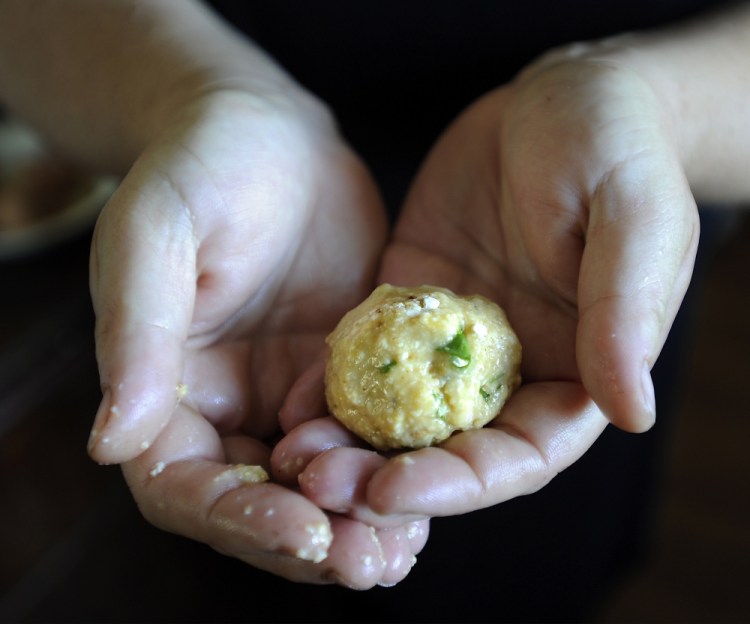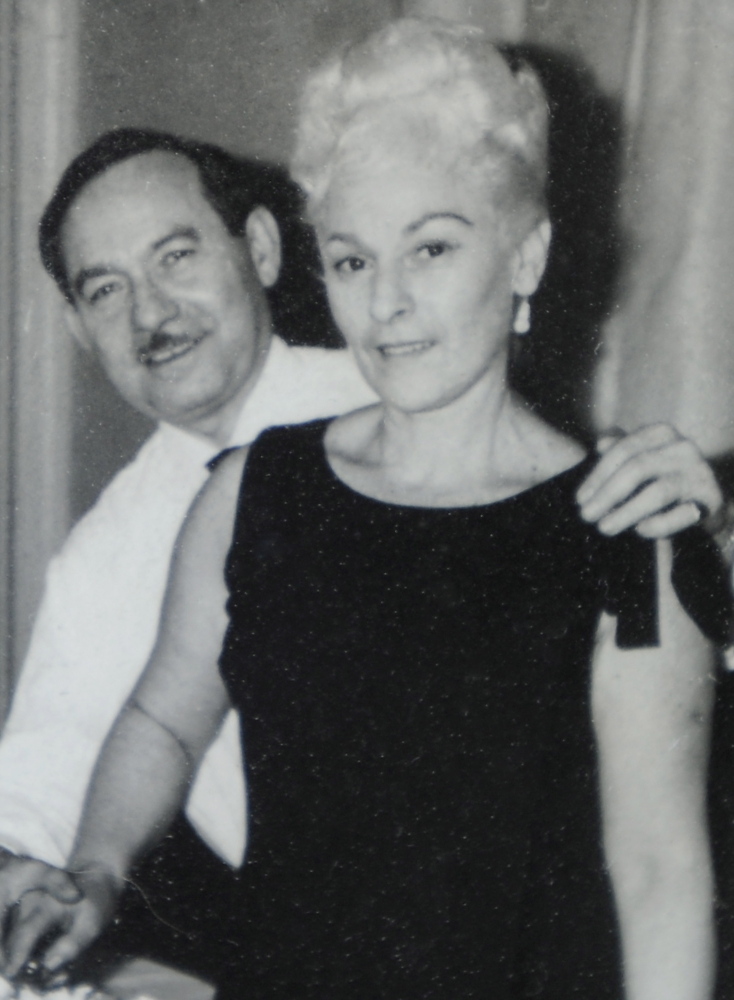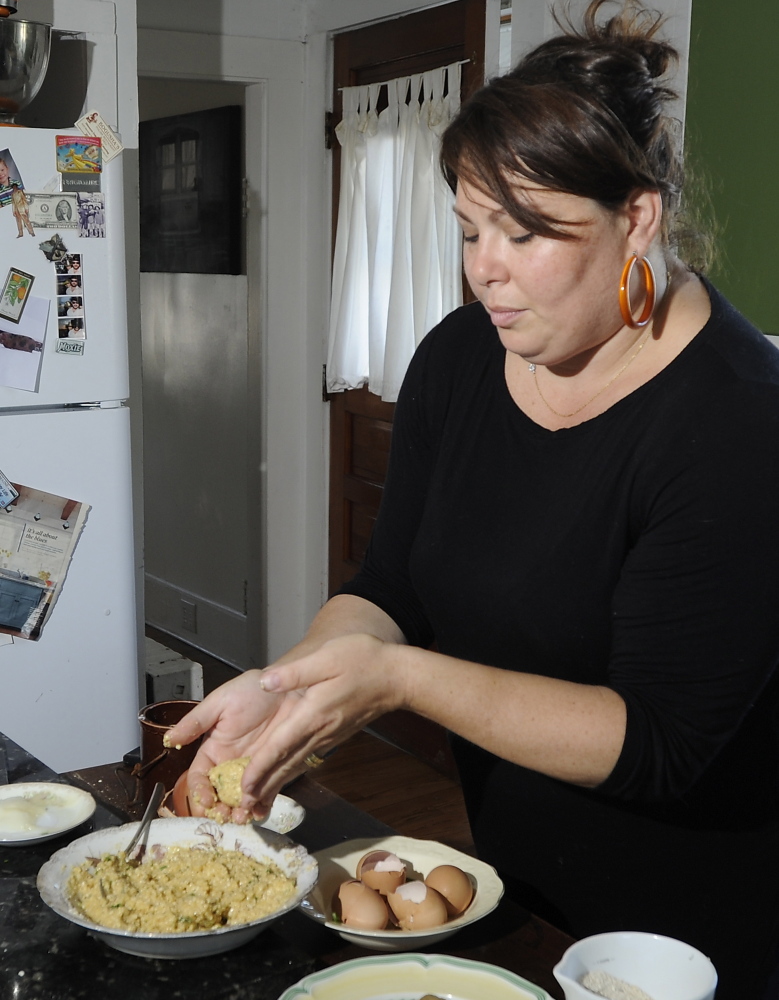I learn a ton from my friend Ali Waks-Adams, whose culinary knowledge dwarfs my own and whose palate I trust implicitly. Last week she taught me to eat horseradish leaves.
She’d invited me and my family to celebrate Rosh Hashanah in her home well in advance of sundown on Sept. 13. In the time that passed between the invitation and the meal, she relished the process of developing a menu that was both traditional and her own.
One evening she and her husband, Christian, were watching “Chopped,” the Food Network’s reality show that pits three chefs against each other and the contents of mysterious market baskets. In this episode, the chefs were challenged to use horseradish leaves. Ali had previously assumed they were poisonous, like rhubarb leaves.
Learning they were edible, she considered the horseradish plant she inherited from her grandfather Hy, who used its roots during the family’s Passover Seders in Brooklyn, and which she subsequently hauled up from Philadelphia last year and planted in the backyard of her Brunswick home, where it is flourishing. When Christian said, “You should put those in your matzoh balls,” Ali’s most recent twist on tradition was born (recipe below).
At the first bite of the matzoh balls – my first ever – the horseradish taste was not all that evident. The flavor was more cumulative, adding up with each bite, bringing a complementary flavor to the dill with which Ali had garnished the soup.
Ali also taught me Rosh Hashanah is a time for reflection on how we could do things better in the coming year. I reflected upon the other leaves I could cook with instead of toss. The improvement would help reduce my family’s food waste quotient.
Like horseradish leaves, which taste like spinach with a kick, most edible leaves reflect the flavor of the fruit or vegetable with which they are biologically bound. Sometimes it’s stronger, sometimes weaker, and many times there is a bitter tinge.
Celery leaves came to mind almost immediately, both the soft celedon ones tucked inside the bunch and the larger dark green ones that have matured longer on the stalks. I use the former chopped in celery and fennel salads and the latter more like an herb, chopping it and sprinkling it anywhere I would use parsley.
Less obvious are kohlrabi leaves, which are still attached to the vegetable in farmers market now, but will be trimmed off the bulbs before they go into cold storage for overwinter sales. They work anywhere you’d employ green cabbage: in a slaw, a stir-fry or filled like golumpki or holubki.
I’ve always felt guilty about breaking up the beauty of a bunch of radishes right when I buy them, but stashing the lot in the fridge for a few days makes the leaves limp. Cookbook author Deborah Madison in “Vegetable Literacy” adds radish tops to a basic potato soup for delicate green color and radish flavor. If you want a stronger, more turnipy flavor, Madison says to sauté them with olive oil and garlic before pureeing them into the soup.
My biggest surprise in pondering this leafy question was finding a use for pumpkin leaves. In Italy, the fuzzy leaves are deveined just like chard, sautéed quickly and added to stewed pumpkin dishes. Top the dish with roasted pumpkin seeds and the waste loop is completely closed on this dish.
MATZOH BALLS WITH HY’S HORSERADISH
Ali Waks-Adams says there are many personal preferences when it comes to matzoh balls. She prefers sinkers over floaters, with a texture soft enough on the outside to soak up the soup but al dente enough at the center to give you something to think about. In this recipe she adds horseradish leaves from her grandfather Hy’s plant and, in a radical twist, places a traditional flavor from the Ashkenazi Jewish table in a very unexpected place.
5 eggs
1/3 cup cool melted schmaltz (rendered chicken fat), duck fat or use vegetable oil
2 tablespoons finely grated onion
1/4 cup minced horseradish leaves
1/4 cup minced fresh dill or 11/2 teaspoons dried
1 teaspoon finely grated garlic
A bisele* of ground pepper, a bisl** of kosher salt
1 cup matzoh meal
In a medium-sized bowl, whip eggs, schmaltz, onion, herbs, garlic, salt and pepper together with a fork until well combined. Gently mix in the matzoh meal. The result will be a thick paste. Cover the bowl tightly with plastic wrap and refrigerate at least 1 hour, but for best results overnight.
When you are ready to cook the matzoh balls, set a large pot of salted water (how salty? Like tears, that’s how salty) over high heat to boil.
Set a bowl of cold water at your side. Dampen your hands in the cold water and scoop up about a walnut-sized bit of matzoh mix. Gently roll the mixture between your palms to round it out; don’t pack, don’t squish. Lay the ball on a lined cookie sheet. Repeat until you have about 18 balls. The number 18 equals chai, which is a lucky number, so it’s good to aim for that number, but you may have more or less depending on the size of your hands.
When the water is at a full boil, gently place all the balls into the pot. When the water comes back up to a boil, cover and lower the heat to a low simmer. Cook 20 to 30 minutes – they will rise to the top when they are done. Test one to see; it should be soft but a little bit chewy in the center. They may deflate a bit as they cool. It happens.
You can freeze them at this point for later use. Let cool, then freeze in a single layer on a sheet pan; when frozen solid, transfer to a freezer baggie. Allow to defrost before warming them in soup.
To serve them immediately, place in a bowl of hot chicken soup or alongside a nice brisket with onion gravy and extra horseradish.
* a tiny bit
** a little bit
Christine Burns Rudalevige is a food writer, recipe developer and tester, and cooking teacher in Brunswick. She writes about feeding her family Maine seafood at familyfish.net. Contact her at cburns1227@gmail.com.
Send questions/comments to the editors.






Success. Please wait for the page to reload. If the page does not reload within 5 seconds, please refresh the page.
Enter your email and password to access comments.
Hi, to comment on stories you must . This profile is in addition to your subscription and website login.
Already have a commenting profile? .
Invalid username/password.
Please check your email to confirm and complete your registration.
Only subscribers are eligible to post comments. Please subscribe or login first for digital access. Here’s why.
Use the form below to reset your password. When you've submitted your account email, we will send an email with a reset code.